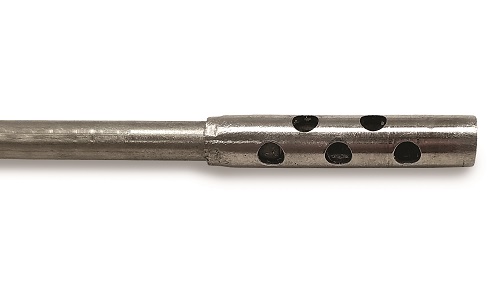Comparing the Three Main Types of Temperature Probes & Sensors
게시됨 12월 09, 2019 으로 Advanced Energy Editor
.jpg?lang=en-US&width=161&height=97) |
 |
 |
This blog post compares and details the three types of temperature probes & sensors most commonly found in measurement instruments today; thermocouples, Resistance Temperature Detectors (RTDs), and thermistors.
Thermocouple Temperature Probes & Sensors
Thermocouple probes are available in a variety of forms. These range from fine gauge wire, possibly with a washer for attachment up to a metal-clad, mineral insulated (MI) cable for industrial applications. Wire thermocouples are available in heavy gauges (8 or 10 AWG) for high temperature measurements or insertion into thermowells down to a very fine gauge (36 AWG) which offers very fast response times. MI cable probes can have three different junctions: an exposed junction for air/gas measurement and fast response; a tip-sensitive grounded junction that has fast response in liquids but maintains the protection of the outer jacket; or, an ungrounded junction which offers noise and electrical isolation but has a slower response time. MI thermocouples can also be used for heavy duty applications, such as penetration probes for frozen food or insertion into the earth.
Thermocouples are available in different alloys. These were developed over the years to meet specific measurement application requirements.
Base metal thermocouples: Types E, J, K, N and T
- Types T and E are the most accurate
- Types K and N perform best at high temperatures
- N has less drift at prolonged high temperature
- Type J is an industry standard because it is the oldest
Noble Metal thermocouples: Types B. R, S and (unofficially) Type P
- Types B, R, and S are Platinum Rhodium and used for High Temperature Measurements
- Type B is for extreme high temperatures
- Type P, also known as Platinel, was formulated to approximate the K curve. It contains some gold and palladium and is also used for high temperature measurements. It has a higher output than the Platinum Rhodium types.
Tungsten-Based Thermocouples: Types G, C, D
- Types G, C, and D are used in Hydrogen, inert, or vacuum atmospheres at very high temperatures
- Selection can be based upon instrumentation and availability
To display, control, or log temperature data, thermocouple thermometers are readily available and relatively inexpensive. These instruments are available in a variety of forms including panel meters, controllers, dataloggers and handheld thermometer devices. Thermocouple wire is available with many types of insulation including PVC, Teflon, Fiberglass, Kapton, and Ceramic Fiber. Metal over-braiding is also available to add abrasion resistance. For the most rugged needs, a mineral-insulated metal-jacketed (typically Stainless Steel or Inconel) thermocouple cable provides optimum protection.
Industrial components, like thermowells for insertion into pipes or tank walls, or probes with metal heads to protect the connections, are also available for thermocouples. Thermocouples for scientific applications come in forms such as thin ribbon elements for surface measurement, adhesive-backed, hermetically sealed, or very fine exposed wire for fast response in air or gas.
Resistance Temperature Devices (RTD) Temperature Probes
The electrical resistance in Resistance Temperature Detectors (RTDs) changes as a function of temperature. The most common RTD Probes are made from high-quality conductive metals, most commonly platinum. RTDs are offered in four different levels of accuracy (Class AA through Class C). The linear resistance change from RTDs results in very accurate temperature measurements.
It is important to consider several factors when determining if an RTD probe is appropriate for your measurement. For example, an RTD element is larger than a thermocouple junction so this must be considered when determining how to mount the sensor. The lead wire can be copper, but because the RTD is a resistance measurement, a compensating resistance measurement method, such as 3-wire or 4-wire, should be used to compensate for lead resistances. The equipment to which you plan to attach the RTD may also determine the type of wire system needed. Make sure the insulation can withstand the temperature ranges in the application and is strong enough to protect the leads from abrasion. If there is flexing involved, consider using stranded wire since it is more flexible than solid wire. Keep your leads as short as possible to minimize errors. The instrument will also have a maximum lead resistance specification. Do not exceed it! In some industries, such as food or pharmaceutical, there may be environmental or special regulations that could require a specific type of wire insulation.
Vendors offer RTD thermometers in a wide variety of standard form factors, such as panel meters, controllers, dataloggers and handheld devices. These are readily available and relatively inexpensive. RTDs are often used in high accuracy applications. If that is the case, double-check that the instrument’s specifications support the accuracy you need for the application.
RTD/Copper sensor wire is available with many types of insulation including PVC, Teflon, Fiberglass, Kapton, and Ceramic Fiber. Metal over-braiding is another option available to add abrasion resistance. For the harshest environments, select a 3-wire or 4-wire copper conductor mineral insulate metal jacketed cable for RTD sensors.
RTD temperature probes are available in many of the same form factors as thermocouple probes. Typical RTD systems offer a variety of add-on industrial components, such as thermowells for insertion into pipes or tank walls and probes with metal protection heads. Scientific-style RTD probes, such as small thick film or thin film elements with adhesive backing or elements hermetically sealed in Teflon™ PFA, are also available. Additionally, small thin film element-style RTD temperature probes provide relatively fast response times in air or gases.
Although most RTDs are platinum, vendors do offer special-purpose RTDs made of copper for use in motor windings or nickel RTDs for low-cost, narrower range applications like air conditioners and consumer goods.
Thermistor Temperature Probes & Sensors
Like an RTD, a thermistor is a type of resistor which varies with temperature. Thermistors differ from RTDs in the material used. Generally, they use a ceramic or polymer embedded in glass as versus the pure metals used in RTDs. Thermistors come in many forms, such as beads, rods, and discs. There are also many leaded and surface mount packages available. Thermistors typically deliver greater accuracy, but within a more limited temperature range than RTDs. The key distinction for thermistors: They deliver a large change in resistance as an almost parabolic function over a small temperature range.
The Steinhart-Hart equation (with parameters supplied by the manufacturer) is most often used to define the curve, or the Alpha/Beta formulation, which is a narrow-range simplification and usually calculated from the S-H parameters.
When selecting a thermistor probe, review the resistance curves of the thermistor options for the desired application. If you are using an Alpha/Beta formulation, be sure that the center of the temperature range or control point is in the middle of the thermistor’s range. If you are using the full limits of the thermistor’s range where some areas have small resistance changes, then use the full Steinhart-Hart equation.
Thermistor accuracy is usually stated as “interchangeability,” which can be as close as 0.1°C or 0.18°F. Thermistors are found in applications that require fine temperature control and this interchangeability. Because their mass is very small with a limited range of 150°C, they deliver a response time comparable to a small thermocouple. Many thermistor probes are used in appliances, so their form factors are often designed for mounting in a small chamber rather than in a more industrial setting. Many forms are available in surface mount styles, but immersion and surface models are also available.
A thermistor system uses a copper connecting wire. The measurement is still a resistance measurement, so for best accuracy, use a 3-wire or 4-wire connection to compensate for lead resistance. Be sure to protect the leads through the entire wire path back to the instrument. Leads must be kept as short as possible. In addition, consider abrasion and flexing when selecting lead wire. Copper sensor wire is also available with many types of insulation including PVC, Teflon, Fiberglass, Kapton, and Ceramic Fiber. Metal over-braiding is again an option to add abrasion resistance. For the most rugged needs, 3-wire and 4-wire copper conductor mineral insulate metal-jacketed cable can be used with the thermistor.
Thermistor thermometers must be able to work within the resistance curve of the thermistor. Panel meters, controllers, data loggers and handheld devices are not as common for thermistors as for thermocouple or RTD instruments, but are relatively inexpensive. Heavy duty industrial components, like thermowells for insertion into pipes or tank walls, and probes with metal heads are not as readily available for thermistor systems.
Interested in learning more? TEGAM designs and manufactures a full-range of digital thermometers for different applications, including intrinsically safe digital thermometers for use in areas where combustion is a concern. Please contact us if you have specific questions left unanswered in this blog post – we’ll respond quickly. Visit our Temperature Probe Guide infographic here for visual learning. Thanks for reading!
